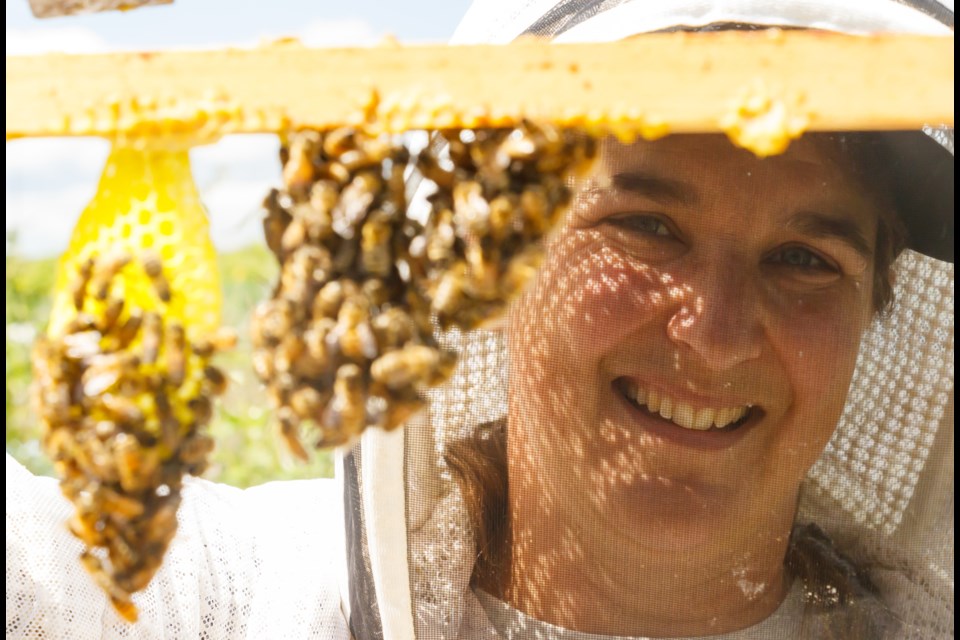COCHRANE— The flowers in the Cochrane area are in full bloom and pollinators are abuzz helping the ecosystem thrive.
National Pollinator Week, running from June 21 to 27, is celebrated around the globe in recognition of the important role pollinators play in the natural ecosystem and agriculture.
Pollinators Week serves as a great opportunity to learn about native species that help support the ecosystem in and around Cochrane, said Hive and Harvest owner and beekeeper Gisele Hardock.
During the summer months families can explore the great outdoors and the creatures that make Cochrane special, Hardock said. It is a fun experience for families to spend time in nature fostering a love for the flora and fauna.
“I think the more we connect with nature, the more we protect nature,” Hardock said.
It is important to support native pollinator species because they are not managed in the same way as honey bees.
“They're [native pollinators] the ones that are more threatened,” Hardock said. “As beekeepers, if we have a hive die, we can take another hive and split it and we increase our numbers fairly easily and recover— But, nobodies doing that for the bumblebees or the solitary bees.”
The loss of natural habitat and certain native plant species can prove devastating for pollinators in Alberta.
Bumblebees and solitary bees are unique in comparison to honey bees because they require small amounts of food to forage. A hive of honey bees requires a tree in full bloom or a field of dandelions to support the hive, while wild bees need smaller food caches because they live in less dense populations.
“They’re not really competing for the same resources, unless you have an over saturation of bees,” Hardock said.
The biggest step people can take to support local pollinators is planting more flowers, especially species native to the Cochrane area. Hardock said this can be especially significant in the spring when there are fewer plants for the bees to forage from.
“A lot of the solitary [native] bees will be specialists and they only will eat pollen flower from one plant. If there’s none of that plant, they won’t have anything,” Hardock said, explaining the symbiotic relationship between native plants and pollinators. In many cases, the plants bloom at the same time bees emerge in the spring.
The practice of planting native flora is especially important in urban areas where blooms providing pollen and nectar can be in short supply.
“A pot of plants on your balcony if you live in an apartment, or a little garden is really going to help give them something to eat,” Hardock said. “There are some bees that live in this little world right beside this bush that they feed off of. Every year they go and they nest in the ground beside the bush and they’ve been doing it for generations— If you chop down that bush, they’re in trouble.”
For those looking to find out more about native pollinators, Hardock recommends connecting with Bumble Bee Watch a collaborative citizen science project to track and conserve North America's bumblebees, or the Alberta Native Bee Council.
Cochranite Dr. Robert Este often explorers the hills in GlenEagles leading down to Cochrane, documenting the wildlife in the area through photography.
“There are an awful lot of pollinators in the area,” Este said. “On the natural hillside it’s not an agriculture site, it hasn’t been plowed, it’s not planted. It’s a wild hillside. All the plants, and so on, on the hillside coming out of the Eagle View area they’re all-natural— Except for those that have been introduced over hundreds of years.”
The ecology on the hillside is well established and plants such as wild roses and thistles emerge each year ready to support pollinators. The plants in turn rely on the natural pollinators in the area to survive.
“You have lots of different types of bees. You have arachnids, meaning spiders and all kinds of things like that, you’ve even got some mammals that accidentally serve as pollinators for the plants and even some birds,” Este said. “There’s a lot of activity on the hillside.”
The ecosystem in GlenEagles is abuzz with pollinators, he said, and those walking or hiking in the Cochrane area will be able to spot a plethora of different pollinators supporting the ecosystem.
“If your natural environment is full of activity, you’re a part of that environment too,” Este said. “Pollinators are crucial for what we do, where we live and what we enjoy— If we lose those guys then we’re really in trouble.”
Dozens of distinct types of bees call the Cochrane area home and it is eye-opening and exciting when one can begin to recognize the different species. Alberta alone has around 15 separate species of bumblebees.
“All of them are essential for visiting all the different types of plants for pollination,” Este said.
On any given walk, Este said, he encounters a rich mix of bees, including many who are solitary and live on their own. He has also encountered spiders aiding in the pollination process.
“I took a picture of a crab spider on a little rose petal. It’s predatory it’s going to grab whatever comes flying by and it will eat whatever it catches. But, while it’s there it picks up some pollen by mistake and goes somewhere else and drops it off at another rose,” Este said. “What the spiders do is not enough to keep it going, but they do help out.”
If people are interested in learning more about pollinators Este recommends starting with Google and digging into the insects that act as pollinators. He encourages people to learn about all the different pollinators in their backyard and the best ways to support and enjoy them.
"They’re a treat for us to be familiar with and for us to understand," Este said. "If you let them be … They’ll do their job.”




